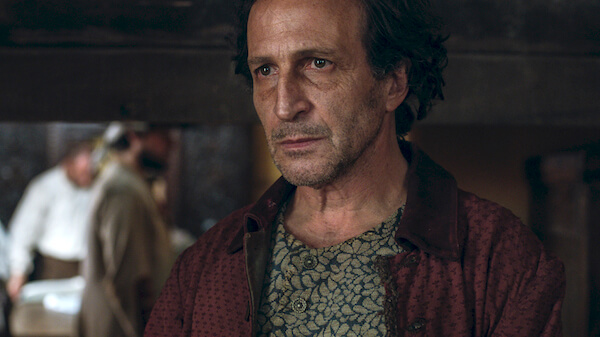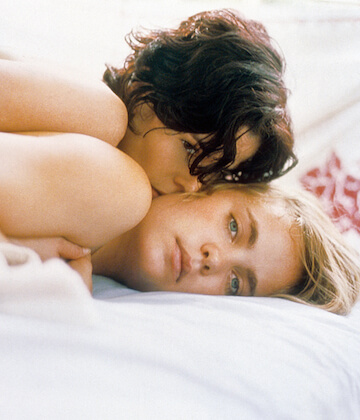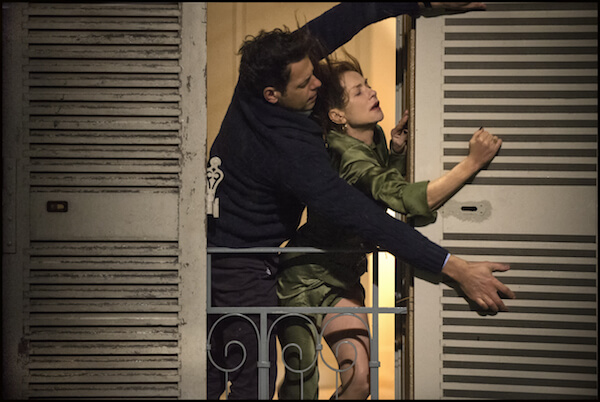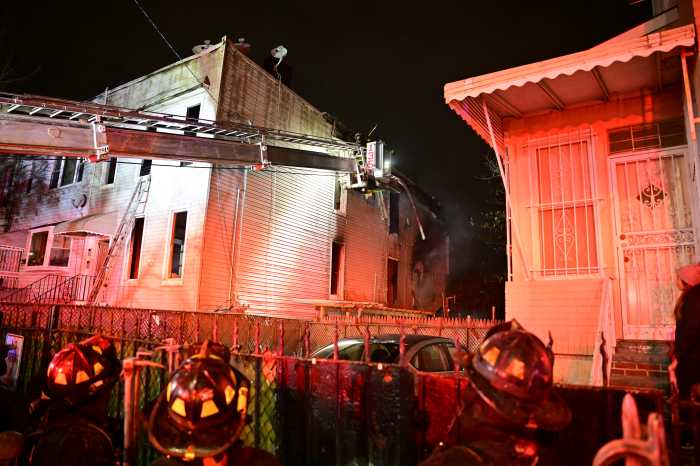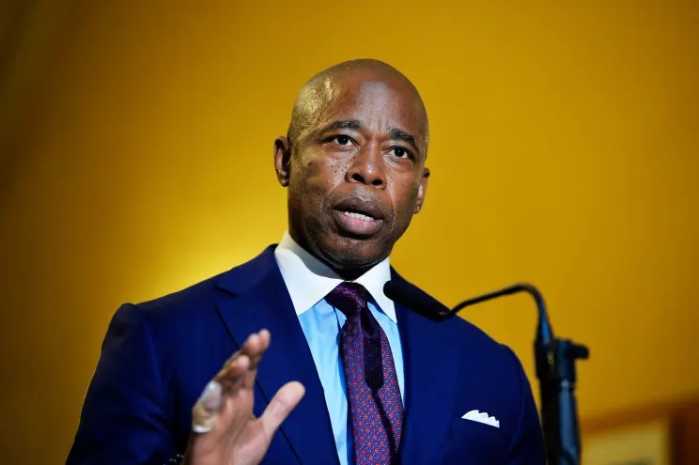Alvaro Gonzalez, Luke Miller, Antonio Ramos, and Darrin Wright in Ramos’ “Almodóvar Dystopia.” | PETER YESLEY
For those who love dance, the films of Pedro Almodóvar, and the human body, I suggest “Almodóvar Dystopia,” Antonio Ramos’ choreographic, multi-media vision, playing at Dixon Place through September 30.
The bearded, ebullient Ramos described his piece as “a general view of Almodóvar’s work, and it’s more about his process. Some of his films I have drawn upon are ‘All About My Mother,’ ‘Volver,’ ‘Talk to Her,’ ‘High Heels,’ and, of course, ‘Tie Me Up! Tie Me Down!’ I think Almodóvar and I may share creative processes, improvising and putting layer after layer over our original concepts. As a choreographer, sometimes I make my dancers learn a piece of choreography all by themselves, and then I put this dancer with the others and it all comes together.
“We have some great collaborators on this piece: genius Alex Romania has created multi-media with green screen, and we are incorporating some videos from our previous residencies. Our costumes are by Claire Fleury, whom you know, so you know the kind of amazing cuts and colors she will bring. David Drake is bringing the dramatic stuff, directorially, for our script includes spoken word.”
Oh, and there will be nudity — a lot of it.
Queer multi-media homage at Dixon Place; Annette O’Toole in George Kelly gem
“I like it. A lot of the dancers will be naked through the whole piece, changing into costumes onstage, and high heels, of course. In fact [laughing], I almost named this ‘Almodóvar Dystopia: All About My Butthole.’”
And if you think Manhattan art circles are any more sophisticated about this than the rest of the country, for which seeing a penis is even more verboten than watching an ISIS beheading, Ramos ran into problems with the New York Times photographer sent to shoot his company: “She was crying, ‘I can’t take a picture — there are penises flying everywhere!’ I was really upset by her comment, especially when she went to all the dancers, saying the same thing. If my dancers are brave enough to perform for an hour-plus naked, they should have some respect! And why hide the penis? It’s a beautiful thing. Maybe if it wasn’t so hidden there would be less real perverts around.”
Ramos’ choreographic intention is to show “how in Almodóvar’s dramas, we have an eccentric culture that goes to every extreme. When I look at his films, all his women are like us, so messed up, but we cover it up with a front, while all these crazy things are happening politically and with gender and race. It’s a celebration of being alive, showing the neuroses of living in a multicultural society. It represents everything and nothing at the same time. Some characters in his films are representative of the fascists he grew up under, and here we are at this time with people controlling us, trying to take us back to 100 years ago. I feel that, to them, my community — immigrants, the poor, artists, gays — have become the Other. But the ending is celebratory — it has to be — about where we are and what it could be. Oh, and there will be some food for the audience, as well!”
Ramos’ dancers range in size, age, and race, from native New Yorkers to two from Puerto Rico and Chile “to give it a little more Latin flavor. One thing that I’ve noticed in Almodóvar’s films and I’ve always wanted to ask him about was that there are very few people of color, mostly whites. I don’t know if it’s because he wants to copy Hollywood movies, as he refers to them constantly as inspirations, or what, but a person of color is never a main character.”
Choreographer Antonio Ramos, whose multi-media vision based on the films of Pedro Almodóvar plays at Dixon Place through September 30. | DAVID NOH
Born and raised in Puerto Rico, Ramos moved to New York when he was 17.
“I was a totally shy country boy, and the dance community was a supportive space that supported queerness, not just sexual but also being weird or funny,” he said. “Back home, I started dancing at 14, folkloric dance. My parents did not support my dancing, and my father wanted me to be a plumber. He said, ‘If you want to dance, you have to find someone who can give you a ride to your classes.’ So I found somebody who took me to San Juan and then back to the countryside, really late.
“Our relationship is funny now. He never tells me he loves me, only ‘God bless you.’ That generation, it’s so hard to express their feelings! But as I got older, I became more patient and understanding. They love me more when I’m back now.
“But I had to leave, I said, ‘I’ll shoot you all if I don’t!’ I came to New York and joined Ballet Hispanico at 17. Then I got my degree from SUNY Purchase, which wasn’t good for anything but it got me out of the tweena [post-ballet] stage. I did a lot of underground queer dance stuff, even go-go once. I didn’t like it then, but now that I’m older, I think I would [smiles].”
Although Ramos has to support himself with massage therapy, leaving him beyond exhausted after a day of rehearsing, Ramos has enjoyed the benefits of various residences in places like Genoa, and, particularly and more locally, El Museo del Barrio: “We were working on ‘Neverland,’ inspired by this queer African-American girl who went to Europe and connected with the queer dance community. We were naked in the space for almost six months while the museum director not to mention the cleaning staff would be there. Unfortunately, we were only able to do one performance, but I love that piece and hopefully we can do it again. There’s an online video of it that has had many, many viewers.”
Annette O’Toole. | COURTESY: COYLE ENTERTAINMENT
George Kelly (1877-1974) was one of those solid American playwrights from the first part of the last century whose canny craftsmanship does not get revived nearly as much as those ubiquitous warhorses O’Neill, Williams, and Miller. Thanks then to Peccadillo Theater Company for reviving his smash success 1924 comedy “The Show-Off” with a lovely cast, including the exceedingly lovely Annette O’Toole.
“I thought it was a British drawing room comedy or something,” she told me about what she’d always heard about this play. “But it’s American through and through: George Kelly was born and bred in Philadelphia, Grace Kelly’s uncle.”
O’Toole continued, “It’s interesting to work on, and I’m having ball! It’s a marathon, though, I’m hardly off the stage for two and a half hours. So I’m conserving my energy, eating well. I play Mrs. Fisher in this play that was a huge success on Broadway and toured all over the country, so lots of people knew it by the time it was made into a film with Louise Brooks. Kelly won the Pulitzer in 1925 for ‘Craig’s Wife,’ but it was felt that that was a consolation for ‘The Show-Off’ the year before.
“It’s a great role for an older woman, and I’m so grateful they thought of me for it because I don’t know if I would have my own first choice. She’s the matriarch of an Irish Catholic working class family and it all takes place in her home. No Philadelphia Main Line accent, thank God! I know some people, and that’s a hard one to do!
“This character Aubrey Piper comes to court my younger daughter, and he stands for everything I loathe. He’s a braggart who says, ‘A little bluff goes a long way,’ and represents that part of America that is all a bluff, selling something that is actually more than what he has. Kind of like what’s happening now, and what we are reaping the repercussions of. That’s the serious side we are discovering but it’s a very funny play, as he’s up against this woman who’s the embodiment of truth and hard work, not a happy partnership. But I’m not a saint, which is wonderful. I have a lot of flaws, too, and am sometimes crude, but very moral and loves my family.”
O’Toole talked about Kelly being gay. “I read that he had a relationship [with William Weagley, billed in those closeted days as his valet] for 55 years and when he died, the family did not invite his partner to the funeral. Like in a movie, he came anyway and sat in the back, and I get upset every time I think of that.”
Weagley was nine years younger than Kelly, whom he might have met in New York’s Concord Hotel where he was a bellhop, according to some sources. Socially groomed by Kelly, he entertained with him at their house, and the couple even visited Princess Grace in Monaco. But the Kelly family never accepted the relationship, preferring to view Weagley as his servant and making him eat in the kitchen with the staff when they came to visit.
Annette O’Toole and Ian Gould in George Kelly’s 1924 comedy “The Show-Off,” at the Theatre at St. Clement's through October 21. | CAROL ROSEGG
“The Show-Off” comes at the end of a busy year for O’Toole, who was also in Tracy Letts’ “Man from Nebraska” and Horton Foote’s “The Traveling Lady.”
“I’ve been lucky my whole career!,” the long-time Californian explained. “I also went up to Connecticut to work on a new play for three weeks and my husband, Michael McKean, was in ‘The Little Foxes,’ so I’ve gotten to be a New Yorker! I love it, and besides working, soaking it all up and seeing all my friends, my son, Fletcher, is here!
“He’s actually my stepson but I consider him mine, and he works at Trader Joe’s and absolutely loves it. He just got married to his partner of several years, an artist, and the ceremony was in his studio near Trump Tower. So, on November 12, while these two young men were getting their vows, outside there was a protest going on against Trump! Not knowing what was going to happen at that time, there were all these voices shouting, ‘We will endure!’ and ‘Our voices will be heard!’ It was all so beautiful and mystical, and we were all so happy.”
O’Toole made her screen debut in Michael Ritchie’s classic beauty pageant comedy “Smile.”
“That film has such a special place in my heart. I thought then, “This is my very first movie, a big thing in my life, and I’m going to remember this, and I do, vividly! [Legendary dance man] Michael Kidd couldn’t have been sweeter [as the pageant choreographer]. They had a real pageant choreographer come in to do it, and while we were all doing our little routines, Michael recognized that I had danced. So he made me dance captain of one number, ‘Okay Annette, you’re here. Count it off!’ By that point, he was more of a choreographer and hadn’t acted in a while, but I wish I’d had more time to be around him.
O’Toole and McKean have been married for 18 years.
“I knew him for many years to say hi to, as we were in the same circle of actors. But I didn’t really meet him until we were cast in the Lifetime movie [‘Final Justice’], which was shot in Portland. I was still living in Oregon and coming down to LA, enrolling my kids in school. He called me one night, and we realized we were both free at the time. We connected and very quickly after that we knew we were going to be together, get married, and try to find a house where we could all live together, because we had to combine our four kids, aged 10 to 21. We found a great house and loved being there, so many memories, so that’s hard to let go of.”
With McKean, O’Toole has developed her songwriting skills, especially in the hilarious film “A Mighty Wind,” and they’ve collaborated on a musical “which we have been working at for many years. We have the story and all the songs, but writing the book of it has been the hardest because it’s really difficult to sit down and work together. We’ve been acting a lot, separately, so when we’re together we just like to hang out, have fun, go to the movies. We’ve been lazy about it, so maybe we have to get another writer to provide the dialogue.”
Luck and happenstance have certainly figured in O’Toole’s career, getting “Man from Nebraska” when J. Cameron Smith couldn’t do it, and “The Traveling Lady” as replacement for Karen Ziemba, who went into “Prince of Broadway.”
“There are so many brilliant actresses who just don’t get enough work. We’re always up for the same stuff, and it really doesn’t matter who gets it, though, of course, we’d like to play everything. But the only person who gets to do that is Meryl, so we have to take the crumbs off her table [laughs]. Listen, there are so many who could have played my part in ‘The Show-Off,’ and hopefully will play it now that it’s returned to New York. I really, really want to play Gertrude [in “Hamlet”]. I played someone playing her in ‘Hamlet in Bed,’ a wonderful show by Michael Laurence, which we took to the Edinburgh Festival last year, but I’d love to do it for real.”
I asked O’Toole if she knew what Pauline Kael said about her.
“Well, I was in an Americanized, musicalized version of ‘The Entertainer’ with Jack Lemmon, playing another beauty pageant girl with a song by Marvin Hamlisch. I never read reviews, but someone told me, ‘In her review, Pauline Kael likened you to a young Angela Lansbury,’ which was the nicest, most wonderful thing anybody’s ever said about me, so I hope that’s true.”
But that wasn’t what I meant. My friend Stephanie Zacharek, now lead film critic for Time magazine, told me that when she met Kael, she told her, “You have Annette O’Toole hair!”
“Well, not anymore, now that it’s all gray. I was approached at one point to do Clairol ads. But those were the days when serious actresses didn’t do ads. The world is different now. I couldn’t do what these girls do now, God bless ‘em! They all should get whatever they can.”
ALMODÓVAR DYSTOPIA | Dixon Place, 161A Chrystie St., btwn. Rivington & Delancey Sts. | Sep. 15-16, 22-23, 29-30 at 7:30 p.m. | $21; $18 for students & seniors at dixonplace.org | $24 at the door
THE SHOW-OFF | Peccadillo Theater Company | Theatre at St. Clement’s, 423 W. 46th St. | Through Oct. 21: Wed. at 7 p.m.; Thu.-Sat. at 8 p.m.; Sun. at 3 p.m.; Sep. 25, 28 at 7 p.m. | $49 at thepeccadillo.com or 866-811-4111







